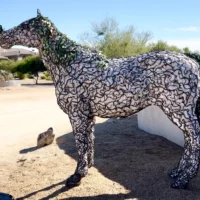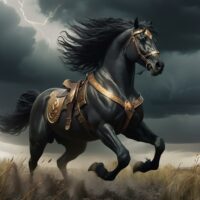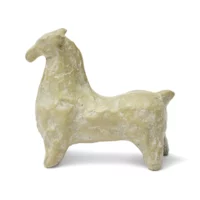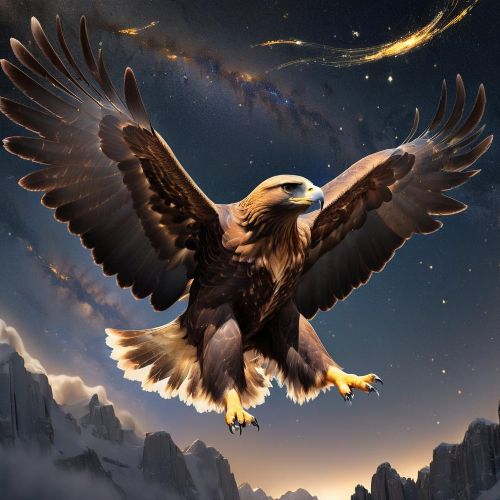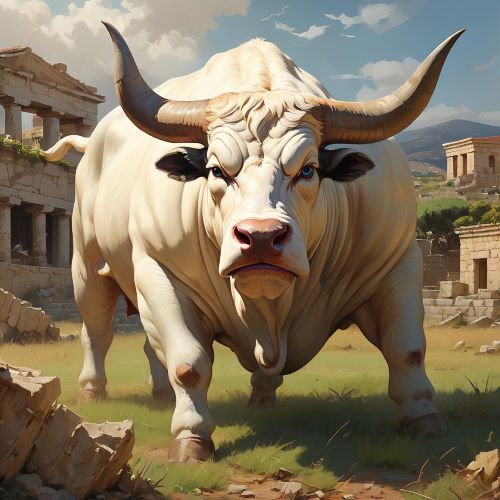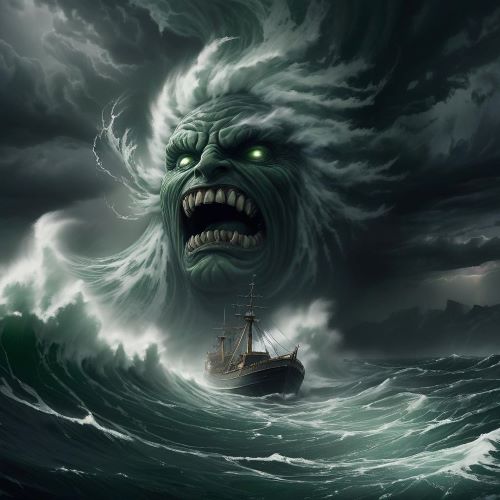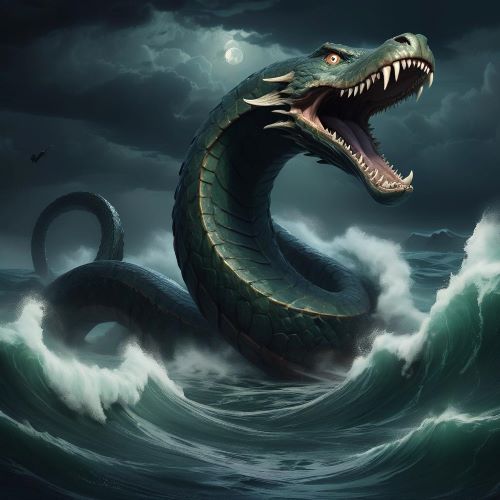Arion : The Divine Horse
Listen
At a glance
| Description | |
|---|---|
| Origin | Greek Mythology |
| Classification | Animals |
| Family Members | Poseidon (Father), Demeter (Mother) |
| Region | Greece |
| Associated With | Immortality, Speed |
Arion
Introduction
Arion (Ancient Greek: Ἀρίων or Ἀρείων) is one of the most fascinating creatures in Greek mythology, remembered not only for his extraordinary speed but also for his divine origin. Unlike ordinary horses, Arion was an immortal stallion whose story intersected with both gods and legendary heroes. He appears in works attributed to Homer, Hesiod, and later writers, embodying a blend of beauty, strength, and supernatural intelligence that set him apart from other mythological animals. Where Pegasus often symbolizes poetic inspiration, Arion represents loyalty, survival, and the intervention of divine forces in the affairs of mortals. His myth carries a distinctive tone of reverence, showing how the Greeks viewed certain animals as sacred beings with roles far greater than those of mere companions or war mounts.
Physical Traits
Descriptions of Arion consistently emphasize his striking presence. The horse is usually depicted with a flowing black mane, sleek body, and dazzling speed that left mortal steeds far behind. His physical form reflected divine craftsmanship, combining elegance with immense power. Ancient sources sometimes portrayed him as possessing extraordinary features such as a voice, which allowed him to speak and advise his masters. Though not always granted wings like Pegasus, Arion was said to run with such swiftness that he seemed to fly across the earth, blurring the line between natural ability and divine magic. His very appearance signaled to all who saw him that he was no ordinary animal but a creature born of gods.
Family
Arion’s birth was rooted in divine drama, tying him to two of the most important Olympian deities. The most widely accepted account identifies Poseidon, god of the sea, and Demeter, goddess of agriculture, as his parents. According to myth, Demeter, pursued by Poseidon’s advances, transformed herself into a mare and hid among the herds of King Oncius in Arcadia. Poseidon, not deceived, turned into a stallion and mated with her, leading to the birth of Arion. This unusual union gave Arion his dual connection to both the power of the sea and the fertility of the earth. Some regional traditions offer different genealogies, attributing his origin to Gaia, the personification of Earth, or even to the West Wind Zephyrus and a Harpy. Regardless of the variation, all versions emphasize that Arion was no product of chance—his very existence was shaped by divine will and cosmic symbolism.
Other names
The horse is often referred to as Areion, a variant spelling that appears in Homeric and Hesiodic traditions. Other transliterations such as Areíôn and Eríôn occur in ancient texts, but all refer to the same legendary stallion. Unlike many mythological beings with elaborate epithets, Arion’s name itself became synonymous with unmatched speed and divine assistance. Over time, the name took on a cultural resonance, much like Pegasus, as a shorthand for strength and miraculous survival.
Powers and Abilities
Arion’s fame rested not only on his beauty and heritage but also on his extraordinary powers. The most celebrated of these was his unmatched speed, which surpassed all mortal horses and enabled him to carry heroes to safety in moments of dire peril. Unlike typical animals, Arion was immortal, never aging and never succumbing to death, ensuring his presence across generations of myths. Some traditions even attribute speech to him, elevating him from a mere beast to a sentient figure capable of counsel. His intelligence was matched by his instinct for survival, qualities that made him invaluable in battle.
Perhaps the most famous episode involving Arion came during the war of the Seven Against Thebes. When the Argive king Adrastus faced total defeat and all other leaders perished, it was Arion who spirited him away from the battlefield, saving the king’s life and ensuring his legacy endured. This act of loyalty demonstrates not just physical prowess but also divine intervention, showing how Arion functioned as more than a mount—he was a guardian shaped by the gods.
Modern Day Influence
The myth of Arion has endured through centuries, inspiring art, literature, and even popular culture. In ancient times, his legend was depicted in mosaics, reliefs, and poetry, often emphasizing the themes of speed and salvation. The “Arion Mosaic” from the Roman villa at Piazza Armerina is one of the most striking artistic representations, capturing the vitality of the myth. Writers from Herodotus to Ovid referenced him, embedding his story into the classical imagination.
In modern literature, Arion makes appearances in works such as Rick Riordan’s The Heroes of Olympus series, where he is portrayed as a talking, swift, and witty horse who aids demigods on their quests. His story has also been adapted for children’s mythology books, ensuring new generations encounter his legend. The themes connected to Arion—immortality, divine protection, and loyalty—make him an enduring figure in storytelling.
Beyond books, his name lives on in equestrian culture. Racehorses, stables, and equine associations have adopted “Arion” as a symbol of speed and strength, linking modern sport with mythic heritage. In fantasy media, traits associated with Arion resonate in other fictional horses such as Shadowfax from The Lord of the Rings, highlighting how mythological archetypes influence contemporary storytelling. Even in popular music and comics, Arion’s name surfaces, connecting him with broader themes of endurance, music, and divine inspiration.
Today, Arion serves not only as a mythological figure but also as a symbol of the timeless relationship between humanity and animals touched by the divine. He embodies the possibility of loyalty that transcends mortality, the bond between hero and companion, and the idea that even in times of inevitable loss, survival can emerge through divine favor. His legend continues to be retold because it speaks to universal human desires—for protection, for speed beyond natural limits, and for the reassurance that loyalty and courage can triumph even when the odds seem insurmountable.
Related Images
Source
Wikipedia contributors. (2025). Arion (horse). Wikipedia. Retrieved from https://en.wikipedia.org/wiki/Arion_(horse)
GreekMythology.com. (2025). Arion – Greek Mythology. Retrieved from https://www.greekmythology.com/Myths/Creatures/Arion/arion.html
World History Edu. (2024, September 30). Arion in Greek Mythology – Origin Story and Adventures. Retrieved from https://worldhistoryedu.com/arion-in-greek-mythology-origin-story-and-adventures/
H. Rose. (n.d.). A Handbook of Greek Mythology. https://www.taylorfrancis.com/books/9781134947560
ARION (Areion) – Immortal Horse of Greek Mythology. (n.d.). https://www.theoi.com/Ther/HipposAreion.html
Frequently Asked Questions
What is lorem Ipsum?
I am text block. Click edit button to change this text. Lorem ipsum dolor sit amet, consectetur adipiscing elit. Ut elit tellus, luctus nec ullamcorper mattis, pulvinar dapibus leo.
What is lorem Ipsum?
I am text block. Click edit button to change this text. Lorem ipsum dolor sit amet, consectetur adipiscing elit. Ut elit tellus, luctus nec ullamcorper mattis, pulvinar dapibus leo.
What is lorem Ipsum?
I am text block. Click edit button to change this text. Lorem ipsum dolor sit amet, consectetur adipiscing elit. Ut elit tellus, luctus nec ullamcorper mattis, pulvinar dapibus leo.
What is lorem Ipsum?
I am text block. Click edit button to change this text. Lorem ipsum dolor sit amet, consectetur adipiscing elit. Ut elit tellus, luctus nec ullamcorper mattis, pulvinar dapibus leo.
What is lorem Ipsum?
I am text block. Click edit button to change this text. Lorem ipsum dolor sit amet, consectetur adipiscing elit. Ut elit tellus, luctus nec ullamcorper mattis, pulvinar dapibus leo.


